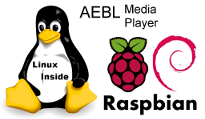To understand what AEBL is, is to understand the history that has lead up to AEBL. This is more technical than many might want and a more concise, executive summary will be published soon.
About 10 years ago, before AEBL was conceptualized, the developer of AEBL was approached by a company (IHDN) to create a computer / software driven electronic device, to replace a hardware device they had developed, which kept failing due to overloaded equipment demand.
The device, now named the XPO, is the brainchild of a former CTV cameraman and producer. It connects between a television network service provider and a television. It senses a commercial insert from the network provider and inserts local, in house content.
This technology has been challenged in the US by network television providers and it was ruled that said providers' challenges against the technologies capability had no merit, and the case was thrown out of court.
A special request was made to the CRTC in Canada, and they deemed it a valid and legal technology as it is functionally similar to a television remote, in that an individual or business / venue has the right to change a channel if they do not like the content being presented.
Due to the nature of the development agreement of the XPO, the underlying software technologies were developed as a framework for the XPO system, with only the detection hardware being proprietary to IHDN, although at the time, it was unclear that the framework technology could be used for any other purpose.
As development of the XPO system progressed, it was found that the technology also worked very well as an ad rotator / digital sign technology. Also, due to the nature of the technology framework, it was discovered that it was much more robust and capable than what the IHDN technology and company required, or desired.
And then came the next stage of development. In order to reduce both the physical footprint as well as the cost of a unit, new technologies were investigated. And the Raspberry Pi was determined to be an excellent replacement for the hardware.
During this phase of development, was when the idea of AEBL was formed. The Raspberry Pi is a very capable device which ultimately functions as a computer. Because IHDN is only interested in video presentation at unique venue and organizational groups, the AEBL designer decided that the world might just be interested in a device that could not only provide audio and video content at a fixed location, but that users might want that same content wherever they go, or even share that content with others, without always having to transfer the content to a device that can display it or relying on cloud technologies which might not be secure or private enough.
AEBL builds on technologies that already exists, including audio and video content distribution methods (such as sound cloud and youtube) and includes social media content and communications, and packages it in a unique, convenient, and extremely mobile format.
An AEBL user can plug their AEBL into their TV or stereo system at home, work, the cottage, or even a hotel room without a locked down A/V system. It can even be connected to your car stereo or connected to the A/V system in your car. When connected to the internet, it can play internet only content, or it can download your content that you want to have, and play it when no internet is available.
That is just a start of what the AEBL is already capable of. As development continues, new and more convenient features will be added as it can be.


No comments:
Post a Comment